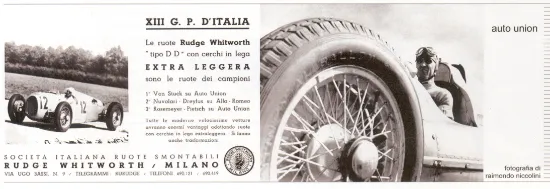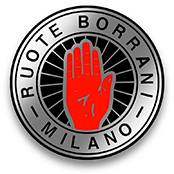Borrani Wheels

Borrani Wire Wheels
We are also able to supply and fit the appropriate tires to your Borrani wheels, please contact us for details, or have a look at this link and choose the tires for you!
The complete Borrani archives include all the original projects and drawings for all standard cars, and for special cars equipped with Borrani wire wheels. This forms a crucial support to answer the wide range of requests from customers all over the world. Ruote Borrani wheels. All Borrani wheels were developed in close collaboration with the related car makers as a complicated and sophisticated technical product. Borrani wheels in most cases were an integral part of the car's homologation and were also extensively tested as such.
All Borrani rims are identified by a stamped RW-code of four or five figures, the unique Ruote Borrani Milano stamping (there are several variations), and a stamped internal production number. These codes also apply to the hubs. All numeric codes correspond with Borrani technical and production documentation.
Borrani wheels cannot have the following characteristics:
- the use of stainless steel spokes
- the absence of the above-mentioned stampings
- the use of spokes of different diameters in the same wheel
- the use of wrong-angled spokes
- the use of non-matching components according to the RW-code of the wheel
The mounting of a non-original, modified or unprofessionally restored wire wheel on your car can pose serious risks and can cause you harm and

Ruote Borrani, Wire Wheels
On April 22nd, 1922 the Italian company 'Rudge Whitworth Milano' was established in Milan, with a share capital of one million, 200 thousand lira. The owner was Carlo Borrani. The Company was located at Via Ugo Bassi 9, and its activity was the production and sale of wire wheels for cars, motorbikes, cycles and equivalent'.
This was the official beginning of the remarkable Borrani wire wheel story. Production started with a licence from Rudge Whitworth, Coventry, which had registered a patent for mounting a wire wheel on a hub by a unique splined drum, fixed by one central lock nut. This made for easier and faster mounting and dismounting of the wheel.
This also aroused the interest from the most important racing cars constructors. After just 12 months in business, Alfa Romeo, Auto Union, Bianchi and Lancia started to equip their racing and de luxe cars with Borrani wire wheels.
Later in the 1930s the Company modified its name to Carlo Borrani S.p.A. During this same period Borrani started to experiment with light, rigid aluminium rims to replace the usual steel rims.
TIMES OF GROWTH
In 1955 the premises in Via Bassi became inadequate for the rising monthly production volumes, that increased from one thousand to one thousand two hundred and then one thousand five hundred wheels in the space of 6 years. The company again changed name into CMR: 'Costruzioni Meccaniche Rho S.p.A.', and moved to a new location. The production of wire wheels went on linked to the Ruote Borrani Milano trademark. Ten percent of Borrani wire wheel production was devoted to racing cars. Ferrari was the best customer of Borrani at that time. This alliance was not accidental, as in 1924 the young Enzo Ferrari ran and won the Acerbo Cup in Pescara with a car equipped with Rudge Whitworth Milano wire wheels.
Borrani also became famous in the motorcycle world as supplier of renowned manufacturers as Benelli, Gilera, Guzzi and MV Agusta. While among car makers even Ford purchased the Borrani wheels for the first version of its iconic GT40 and used them on their Le Mans race cars. Thousands of national and international victories were achieved on Borrani wheels during this period.
Borrani Bimetal Wheels
After a successful period for wire wheels, the cast-aluminium wheel gradually took over the market as first equipment. Looking for new ways, Borrani started to mount a pressed steel wheel disc in their existing aluminium rims. These 'Bimetal' wheels, which were produced already as early as 1954, had their fair share of success and were mounted on famous brands as Alfa Romeo, ASA, Abarth, Fiat, Lancia, Maserati and others.
For more information on the Borrani wheels you require please contact us at sales@borrani.com or on 01302 714072.
